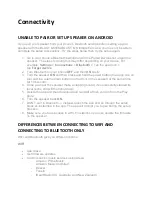
Owner
’s Manual
15
Owner’s Manual
Placement
WARNING: Installation should only
be done by an experienced technician.
Improper installation may result in damage
to the equipment, injury or death. Make sure that
the loudspeaker is installed in a stable and secure
way in order to avoid any conditions that may be
dangerous for persons or structures.
Thump loudspeakers are designed to sit on the floor
or stage as the main PA or as monitors. They may
also be pole-mounted via the built-in socket on
the bottom of the cabinet. Be sure the pole is capable
of supporting the weight of the loudspeaker.
The T100 is a great tripod option and the SPM400
is a nice choice when using a subwoofer.
NEVER attempt to suspend a Thump
loudspeaker by its handles.
Check to make sure that the support surface
(e.g. floor, etc.) has the necessary mechanical
characteristics to support the weight of the
loudspeaker(s).
When pole-mounting loudspeakers, be sure that they
are stabilized and secured from falling over or being
accidentally pushed over. Failure to follow these
precautions may result in damage to the equipment,
personal injury, or death.
Thump loudspeakers may be laid out horizontally as
monitors for the band at a 40˚ angle (as seen below). It
is intended to be used only when the speaker is in its
wedge configuration and works best when on a hard
work surface, like a stage.
As seen above, the Running Man logo is rotatable
for when the loudspeaker is used as a monitor!
Room Acoustics
Thump loudspeakers are designed to sound fantastic
in nearly every application.
But, room acoustics play a crucial role in the overall
performance of a sound system. However, the wide
high-frequency dispersion of the Thump loudspeakers
helps to minimize the problems that typically arise.
Here are some additional placement tips to help
overcome some typical room problems that might arise:
• Placing loudspeakers in the corners of a room
increases the low frequency output and can cause
the sound to be muddy and indistinct.
• Placing loudspeakers against a wall increases
the low frequency output, though not as much
as corner placement. However, this is a good way
to reinforce the low frequencies, if so desired.
• Avoid placing the speakers directly on a hollow
stage floor. A hollow stage can resonate at certain
frequencies, causing peaks and dips in the frequency
response of the room. It is better to place them
on a sturdy stand designed to handle the weight
of the loudspeaker.
• Position the loudspeakers so the high-frequency
drivers are two to four feet above ear level for
the audience (making allowances for an audience
that may be standing/dancing in the aisles).
High frequencies are highly directional and tend
to be absorbed much easier than lower frequencies.
By providing direct line-of-sight from the loudspeakers
to the audience, you increase the overall brightness and
intelligibility of the sound system.
• Highly reverberant rooms, like many gymnasiums
and auditoriums, are a nightmare for sound system
intelligibility. Multiple reflections off the hard walls,
ceiling, and floor play havoc with the sound. Depending
on the situation, you may be able to take some steps
to minimize the reflections, such as putting carpeting
on the floors, closing draperies to cover large glass
windows, or hanging tapestries or other materials
on the walls to absorb some of the sound.
However, in most cases, these remedies are not
possible or practical. So what do you do? Making
the sound system louder generally doesn’t work
because the reflections become louder, too.
The best approach is to provide as much direct sound
coverage to the audience as possible. The farther away
you are from the speaker, the more prominent will be
the reflected sound.
Use more speakers strategically placed so they
are closer to the back of the audience. If the distance
between the front and back speakers is more than
about 100 feet, you should use an external delay
processor to time-align the sound. (Since sound
travels about 1 foot per millisecond, it takes about
1/10 of a second to travel 100 feet.)







































